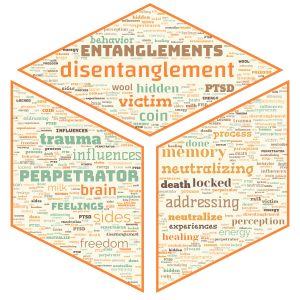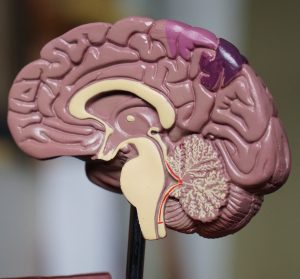My Service
Neutralizing
Taking the first step can be difficult. I offer neutralizing trauma and thus unite the fragments of feelings and memory and allowing it to settle in the brain. That is only the first step in addressing to trauma because then you must address to all the influences that stem from that trauma. That allows you to generate new behaviors that are much more beneficial. My service is done in an energy manipulation. I instruct you in energy what to do and in following them you accomplish the action.


Disentangling
Disentangling a huge tangled ball of wool is a daunting task even if you are doing it in bright daylight. Doing it in the dark is even more challenging or almost impossible. Think about influences of trauma as threads intertwined with what I like to call your genuine-self. To untangle these influences is the next step in addressing to trauma. I also do that by instructing you in energy how to do it. This process takes much longer than the first step in neutralizing. You can expect 3 -24 months depending of the severity of that trauma.
Neutralizing Trauma
Current studies suggest that nearly 90% of the U.S. population, including approximately 40% of children under thirteen, have been exposed to at least one traumatic event. That is including accidents, disasters, the violent or accidental death of loved ones, and witnessing or experiencing interpersonal violence. So you see that trauma is recognized as being running rampant currently. I mentioned this because there may be questions about the number of people who have experienced trauma shared by Elias in my talks with him. When I first heard the percentage, I could not believe it but after investigating the topic thoroughly, I accept it. From an outward appearance, a trauma survivor may look whole and healthy and on the surface seem to be living a successful and happy life. But every trauma festers like an invisible wound, weakening the body’s defenses and wellbeing, generating influences that are not beneficial and that can lead you in a lethal direction if not addressed. The emotional and physical reactions trauma triggers can render you more prone to serious health conditions including heart attack, depression, stroke, obesity, diabetes, and cancer. The risk of developing mental and physical health problems increases with the number of traumatic events you’ve experienced, and unfortunately one unaddressed traumatic experience often leads to the next.
When trauma occurs, in an effort of protection your brain temporarily pauses your normal memory processing system. The traumatic experience isn’t logged and stored properly as traditional memories are, but instead of being stored as a complete memory, the brain separates the memory from the feeling. The memory is split into fragments – it is dissociated. These fragments remain embedded in the mind like shrapnel, impeding the brain’s natural recovery process.
So traumatic experiences are stored as fragments and these fragments are unprocessed. They don’t fit into the system as they should because they are not properlyprocessed. Because they have not settled yet in your brain these fragments can easily surface unexpectedly causing nightmares, flashbacks, or general anxiety and unease, even without any trigger. The brain does this separation to protect you from fracturing your identity. It stores the memory in the right hemisphere of your brain. The right hemisphere of the brain holds trauma memories. It saves them. They become stuck there, because that is the part of the brain that protects us.
The left hemisphere of the brain is, in a manner of speaking, the balanced hemisphere. This is the hemisphere of your brain that knows you are safe and therefore don’t need protecting. This separation of feelings and memory is the reason that clients often report that they may have a feeling of threat or doom, but they cannot find any memory linked to it. Or they can remember a traumatic experience, but they do not feel anything in relation to it. That makes it very hard for those people to trust that this trauma really happened, because they question how such a traumatic experience could not be accompanied by intense feelings. There are many people who have experienced trauma and some even severe or multiple traumas in their past and have no memory about that trauma. That is because many people are choosing on a subjective level to not deal with the them. Therefore their own body consciousness moves in a direction to protect them from that and to protect them from shattering their mental and emotional state.
But anyone that has some degree of trauma who doesn’t remember objectively the experiences, will have experiences with feelings that are what you might to term to be inappropriate. Meaning that they don’t match the experiences. They may incorporate feelings in a situation that are much more extreme than what the situation actually warrants. Or they may have reactions to certain experiences that appear to be inconsistent or inappropriate. They don’t match with the situation. You will give yourself excuses and explanations why you have such inappropriate reactions. But most likely you will also notice that you have repeated reactions that seem to be more extreme. And you may notice that other people don’t have those reactions.
You can identify that you have had some type of trauma based on your behaviors in your life, such as being compulsive about certain actions or being an over-achiever or being an under-achiever or being driven to excess or expressing a temper, that seems to be very inappropriate, or being very judgmental in extremes. These are all learned behaviors. They aren’t natural. You aren’t an excessively judgmental individual naturally. You develop these behaviors in relation to trauma. When trauma is unaddressed, it is trapped in a way. Your body feels it and your brain tries to make sense of it, but it does not recognize the difference between physical or emotional danger in the present or from a triggered past experience. It will react in the same manner as if you were facing an actual threat now.
Every unaddressed trauma will influence the way you think, feel, and act for as long as you have not addressed to that trauma in some manner. That can be for a very long time after the initial traumatic event. The unfortunate aspect of these insidious influences is that you start acting as a perpetrator in some ways. The walls of victim and perpetrator are very blurred because all victims, at some point and in some capacity become a perpetrator. All perpetrators have been victims. Being a perpetrator is the other side of the coin of being a victim, and thus the cycle is perpetuated.
So first you are a victim of some person who acts as a perpetrator and then this experience of trauma influences you in your own behavior and you turn into a perpetrator yourself. Not that you always consciously want to act in this manner (although there are people that do move in this direction later intentionally) – it is happening automatically. Therefore you can unintentionally traumatize other people and so pass this trauma to other people and continue the unfortunate cycle. Sometimes people are a perpetrator to themselves, not to others. They essentially torture themselves. They don't express themselves, they put themselves in situations that are very cold or even detrimental.
In relation to any type of trauma, it is a matter of looking at the behavior one have developed in relation to the influences of the trauma that one has experienced. What I have witnessed in clients is that they are struggling to recall and accept that they have been victims. But they can accept this side of the coin much easier than the perpetrator side. What is very important is, that once they start discovering the perpetrator side, they don’t make excuses for it. They simply realistically look at their own actions that they have expressed in relation to influences to trauma in their live. They have to acknowledge those influences and whatever they engaged is not their fault but it was what they knew at the time.
Even in relation to expressions that may have been harmful to someone else. It is so easy to start judging oneself for actions in the past because now they may have a very different level of self-awareness and are able to see other choices. But at that time of the experience they were a very different person with much less self-awareness and thus were not able to see choices that they see now. It is very important to be gentle with yourself during this process.
I want to make clear that this blurred wall between a victim and a perpetrator is in no way an excuse for any violent or traumatic actions that people engage. But the understanding of the fact that these perpetrators are still victims and that they have not yet been given the right tools to address to both side of the coin is important to keep in mind.
What happens if trauma is neutralized is that the feeling and the memory are reunited. Finally the fragments are put together, allowing a normal processing and the experience can be logged and settle. Then the complete memory moves from the right hemisphere to the left hemisphere of the brain and is deposited in a new groove. That is being done by the subjective awareness, by moving it out of that one hemisphere into the other. In order to do that we have to construct a new neurological pathway in the other side of the brain. That is what the subjective awareness is doing. It is instructing the body consciousness to construct a new groove in the brain, and then move this trauma from the one side of the brain to the other side, thus neutralizing it.
Our brains are extremely adaptable and the brain’s ability to form new connections explains why we can rewire our brains to reverse trauma and it influences. Addressing and overcoming trauma is a difficult process because we are actually changing the way your brain works. We are adding new neurological pathways, increasing the functions of certain areas, and strengthening connections. It’s the same mechanism that allows us to grow and change by learning. But as long as the trauma is not addressed, it is impossible to learn new behaviors or to change behaviors that stem from trauma.
It is recognized that only a minority of people ever develops Post-traumatic stress disorder (PTSD) despite traumas occurring to a vast majority of the population. This suggests that individual differences exist in vulnerability to traumas. While this is definitely true there are other reasons for this observation in my opinion. Condition, diagnostic criteria, central assumptions and clinical utility so far are extremely controversy when it comes to PTSD. And even the definition of trauma over time has undergone a tremendous change. So it is fair to say that there is likely more to trauma and PTSD than currently known.
Post-traumatic stress disorder is different from other traumas. Earlier in our history, it was called shell shock, but shell shock is not an accurate designation for this trauma. The military coined this expression to explain how traumatized soldiers reacted to the sound of bombs. They thought soldiers were suffering from the effects of a bomb's pressure wave. The reason many thought soldiers were suffering from the effects of a bomb's pressure wave was that symptoms suggested it. Soldiers were returning from the trenches blind, deaf, mute or paralyzed. But doctors couldn’t find any physical damage to explain the symptoms. These symptoms were caused by witnessing of people being killed and dismembered that was so affecting. The sound of the bombs was merely the trigger point, but not the trauma. Often these symptoms were seen as a Transient situational disturbance, suggesting that without an underlying psychological condition, the individual’s psychological experiences would wane as the stressor subsided. Which was not the case.
Every experience where one is personally threatened with death or is witnessing violent death generates this special trauma we call now PTSD. This can be very difficult to address to. At the moment psychology cannot completely heal individuals who suffer from this Post-Traumatic Stress Disorder. The traumatized individual can experience lasting complications that seem to be ongoing even when they have addressed to the trauma. This happens because the physical brain doesn’t accommodate all of the experience in moving all of the experience into one groove. That is the reason that it is different from other types of traumas. When somebody experience trauma that is involving witnessing death or being threatened by his own death, or both, this creates another layer of trauma that the physical brain separates into another area. It keeps it in the right hemisphere of the brain, but it creates an additional separation in the right hemisphere of the brain.
The individual may address to the trauma and can remember it and can address to the feelings and can move the memory as one unit, but will likely still have some residual expression. The reason is that because of this type of extreme experience, the physical brain does more than separating that piece, that death piece. The brain moves it away from the rest of the memory. That doesn’t mean that the person doesn’t remember or doesn’t recall that element of death, it simply means that their association with it is not being addressed to. That also requires the left hemisphere of the brain to create an additional groove to hold that piece. That is what is overlooked. Therefore it isn’t addressed and hence this special trauma is often not neutralized completely.
This is seen a lot with soldiers. Unfortunately, what is also often seen with soldiers is that although they may be engaged in some type of therapy to help, most of them remain with behaviors and emotional expressions that are still connected to the traumatic experience. That is because they haven’t been able to move the entire experience and memory to the left hemisphere. They have only moved part of it, and they haven’t been able to create that second construction of a second groove. This is because most of the people that are trained to be working this with these people aren’t aware of that factor.
I approach neutralizing trauma and even PTSD with a different method that bypasses the feelings aspect of the process. I recognize energy and in a way I can “see” the actual traumatic energy inside my clients and can instruct them how to manipulate it. That allows me to reunite the feelings and the memory and move it to the other brain hemisphere, without the client re-experiencing the feelings of that traumatic event. I bypass the memory involvement. This is why my method allows the client to address their trauma without re-engaging it, in varying degrees. Some of my clients have experienced odd feelings during the process or have become very tired. Some still want to recall pieces of the traumatic event, in order to believe that they experienced a trauma at all. That is often the case with clients who have blocked the trauma completely. They do not remember that they have experienced a trauma, and so they have a hard time trusting the process. 
There is a quickly growing group of people who are sure that energy is real. They label it differently and often use terms from the field of quantum mechanics to describe the many odd experiences they have. I do not pretend to understand energy or the many aspects of it completely, but I have learned to see energy and translate energy into a knowing, as well as to manipulate it. I have learned some aspects of energy and certain influences. It took me many years to actually trust my experiences with energy and accept energy as real. I validated as often as possible what I translated from tapping into other persons’ energy. It was like learning a new language and it required feedback to improve my skills.
Let me provide an example. Think about driving a car. It is fair to say that most people who are driving a car have no clue about how the car is actually functioning. That is not required to start the car and steer it. You can learn by driving what influences the car and what is required to keep it working, without fully understanding the mechanics of the other aspects of the vehicle. If you run out of gas, you do not have to understand how the gas is used in the engine. All you have to know is that you have to get more gas, and know how to fill the tank in order to keep driving. I am not able yet to explain to you everything I can do in energy. I cannot explain the exact mechanics of it, but I can steer my energy car very well and I am able to aid you in steering yours in the direction you want to drive.

What I have described is only the neutralizing action of the trauma, the moving of the trauma to the other side of the brain. That is most likely accomplished in two ASC (altered state of consciousness) sessions. However, that is only the tip of the iceberg. Every trauma has generated insidious influences. After the trauma is neutralized, these influences also need to be disentangled from your genuine self, in order to neutralize them as well. It is possible to neutralize the trauma and not disentangle the influence if that is what you want. But it is not possible to disentangle the influences if they are linked to trauma.
Disentanglement
You may have problems to understand what I mean with disentanglement of the influences of trauma. To illustrate this I use the analogy of a huge ball of wool that is in constant motion. Imagine a huge ball of wool, which contains hundreds of different colored threads. I will call this your genuine self. This stays unchanged in the course of your life. But with every experience you make you are generating associations and sooner or later you generate attachments. 
The distinction is important. Basically all colored threads are attachments. But once you have added some into what you believe is you, they are much harder to remove. When you try to remove such threads, you feel as if you are threatening your identity. You perceive that part of your identity is going to be removed. Not that that is really the case but that doesn’t matter. Instinctively you resist that to keep yourself whole. The other reason is that these threads tend to be much longer and are thus more intensely interwoven. That makes these attachments or entanglements as I prefer to call them, to your identity different from normal attachments. 
The difference between you and me is that I am an expert and can see energy clearly something that most likely you are not yet. So I am holding this ball of wool in my hands in bright sunshine while you are holding it in a pitch dark room. Depending on your level of self-awareness you may have a laser pointer in your hand. But even with a laser point, it will be a hard task to accomplish. In additional to that, you may have no experiences in disentangling threads from a ball of wool. You may not believe me that this analogy is much more accurate than you think and that you can do it easily alone. Well I will not argue with you and encourage you to start your own process. I will say that it is possible but it will be a long and often daunting path that you engage then.
Let me offer a hypothetical example:
An individual has traumatic experiences and lived with them a long time. They have generated significant influences because they have been being expressed for a considerable period of time. In relation to these traumatic experiences, the person generated an certain idea and perception about themselves. He feels he is not good enough or he is bad or he is damaged and that he can’t necessarily accomplish because of these factors. He may not even be thinking about it in terms of discounting himself but he do it on a daily basis, perhaps even hour to hour. He constantly incorporate a perception about himself that is perpetuating this piece, this perception of not enough or being bad or being wrong and that he can’t do. That becomes entangled with everything he does and it becomes entangled with who he perceives himself to be. It is entangled with his identity, because he begins to generate this perception that he himself is intrinsically wrong or bad. Everything he does and everything he thinks and every direction he moves in has a potential to be wrong or to not be successful. Not that everything he does is always wrong – but has a definite potential to be wrong or to not be successful because he himself is intrinsically bad or wrong or deficient. In relation to his very identity, it becomes this very tangled web. What that means is that it affects everything in his life because it is being so tangled with everything. It affects what he does, how he does it, how he sees his world, how he interacts with other people. It is automatic and it is very real. It is how he expresses himself in whatever it may be.
It doesn’t matter whether it is a subject or situation that is significant or whether it is something as slight and mundane as pouring a bowl of cereal. Take the very simple action of pouring milk on a bowl of cereal and spilling the milk all over the table. Immediately he generates the assessment and the reaction that that happened because he is inept, because he is bad, because he is wrong and because he can’t do anything correctly. Even this insignificant situation reinforces the person’s perception of himself. Everything is entangled in that perception and it is all tangled in his perception of himself and his identity, who he is. It can be very difficult or challenging to untangle all of that. Because you have no idea or realization of how many branches there are and how many influences there are in everything you do, how you do it and how you speak and think. This entanglements even affect your physical senses, what you see, what you feel, what you touch, everything.
Many times my clients know which behaviors are detrimental, and some have known that for a very long time. They have tried many different methods in altering them in vain. It is exhausting like wandering around in a huge maze and never finding the exit. It is common that people have engaged many different methods to make changes in their lives without success. That in itself is a very strong indicator for a hidden trauma. As I explained, as long as the trauma is not neutralized these attachments are protected and you can try to remove them endlessly and will never be successful unless you have disabled the protection. When I start to help disentangling you I first take a deep look at the ball of wool. I am able to identity what is your genuine self and what is an attachment. So I know what threads are attachments. Not all attachments are bad and need to be removed. It is important for my work to know what is attachment and what is part of your genuine self. Then I generate a knowing how to disentangle you in the most efficient way. I sense pitfalls and sense how fast we can proceed in this proceed without overwhelming you. That all is very difficult for me to explain with words but that is what is happening.
Once I have generated an outline of the process we can start working. It happens as if you were sitting in front of a piano and I am standing behind you. I give you precise instructions what to do and when to do it. Following my instructions you are then doing your own disentanglement. This process happens in energy and there is no physical contact required. It is very important to make clear that even if the neutralizing of your trauma or even traumas took only two ASC sessions the disentanglement will take much longer. The time period depends on the severity and the number of traumas a client has but you can expect a time period between 3 to 24 months. The reason is that in order to not overwhelm yourself you better move in increments rather than taking huge leaps. This process takes place on the subjective level and it is likely that you will not notice much in your everyday life. What you may notice during this process are changes in your feelings, tiredness, mood swings, odd physical sensations, anger surfacing and maybe a slight change in your behaviors. You may generate a feeling of a greater lightness or freedom without knowing where it comes from or what it means. During the whole process I am always available to connect with you if you need it and will answer your questions as well as I can. You need to do nothing else in an objective way. I am aware that this is hard to believe for many people, especially if people have invested much time and determination in many other methods. It is a very strong belief that nothing comes easy and that you have to work very hard for everything but it is also not absolute.
When we are done with this subjective addressing it is a matter of objectively addressing to it. That means that you can start to change behaviors that you were unable to change before and that are very familiar to you. Let’s say that you are taking always the same route from your office to your home. This is familiar and you do not have to think about it any longer. Now after some construction there are several new streets ready for you to choose and you could take a different way home and there might even be a shortcut. But since the old way is so familiar you tend to keep taking the old route instead of choosing a new one. As I hav
So I cannot transport you out of your huge maze but I can give you a map and I can install signs along the way. But it is you who has to walk out of the maze and make different choices than before using and following the map and the signs that we both installed. When you do that and you can change behaviors that are not beneficial and that you do not prefer you are free. You have then accomplished addressing to your trauma and the influences of it. Because one trauma can easily lead to another trauma there are many people with multiple traumas and multiple attachments linked to each trauma. I am not able to address all traumas at ones even if you would be ready. So I will address one trauma or two traumas at max at one time.
Testimonials from clients
© 2025 · Scotty Brampton







